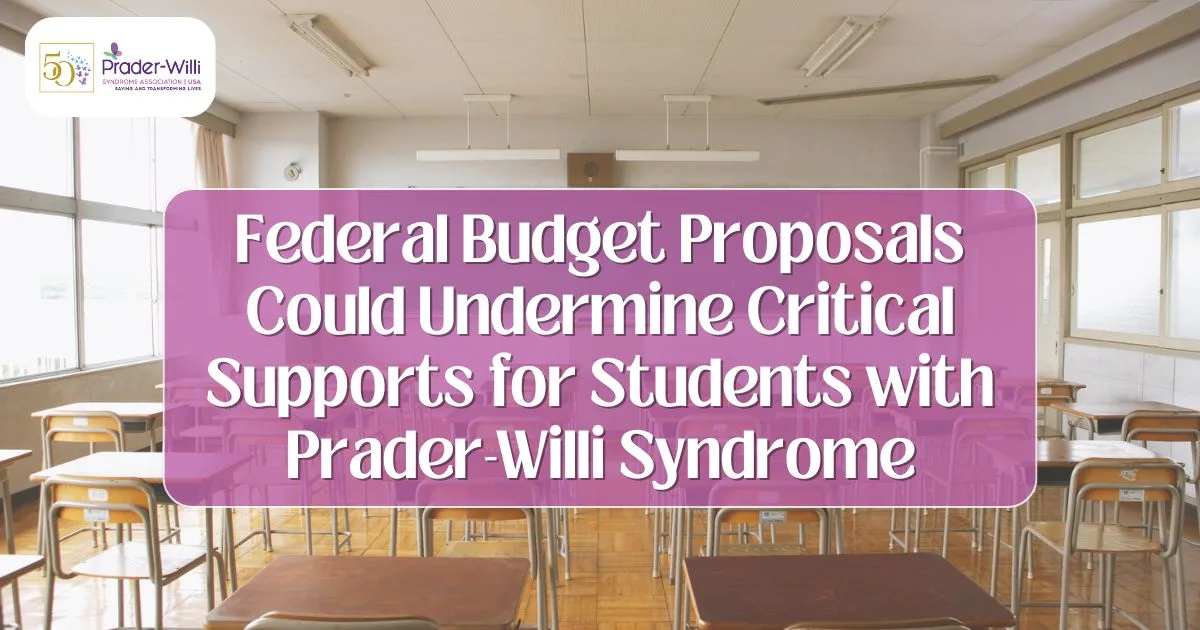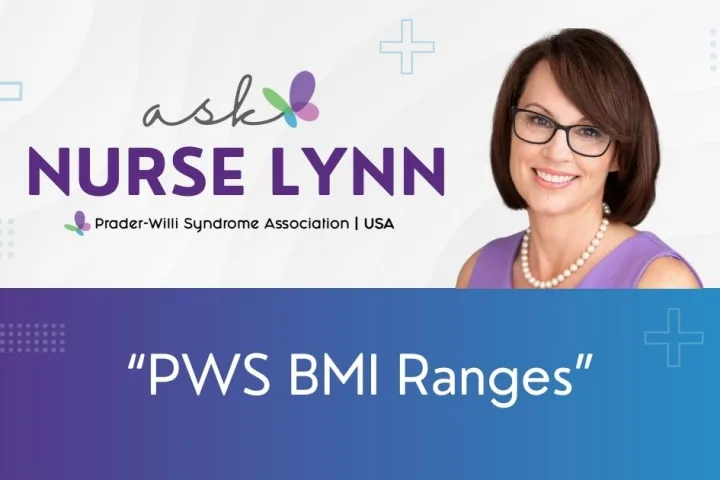Recent federal budget proposals may reshape how special education is funded and could pose real risks to students with Prader-Willi syndrome (PWS). A recent Undivided article, “Federal Budget Proposals That Could Impact Special Education,” notes several concerning shifts in policy (Undivided).
While the administration is proposing $14.9 billion in IDEA Grants to States for fiscal year 2026, an increase of $677.5 million over 2025 and the highest funding level ever for that category, these dollars come with structural changes that may reduce oversight and flexibility (Undivided).
Among the most notable proposals:
- · Eliminate IDEA Part D grants (which fund parent training centers, research, and technical assistance), folding that funding into a single state-level block grant and allowing states full discretion over how to spend it (Undivided).
- · Combine IDEA Part B preschool grants with Part B for school-age children and Part D into one larger grant administered by states, reducing federal guarantees tied to dedicated programs (K-12 Dive).
According to K12Dive analysis, Part B funding in the proposal would equate to roughly $1,944 per student, covering about 10.9% of the average cost of providing special education services (K-12 Dive).
Although some reductions are obvious in other education programs like cuts of $4.5B to Title I, $315M to preschool programs, and smaller reductions to English-learner and adult education the real risk to the PWS community lies in how IDEA’s structure and oversight may be eroded even with flat or slightly increased funding (ennisbritton.com).
Why These Proposals Matter for Students with PWS
Students with PWS typically require a blend of specialized therapies including speech, occupational, and physical therapy, along with consistent behavioral support and environmental controls to manage all their unique needs. They benefit from strong IEPs and comprehensive Health Care Plans implemented by trained staff. These services are essential, not optional, for safety, learning, and quality of life.
Even though IDEA funding is rising, changes like merging funding streams and eliminating Part D grants could weaken parental access to training resources, diminish technical support for educators, and reduce federally enforced accountability. With fewer dedicated supports, states may redirect funds toward other priorities and families may be left to fill gaps on their own.
Potential Consequences of the Proposed Changes
- · Less targeted funding: Consolidating Part D and preschool funds makes state programs more flexible—but also more vulnerable to cuts and reallocation.
- · Reduced oversight: Block grants come with fewer federal compliance requirements, risking dilution of parental rights and IEP mandates.
- · Staff and program erosion: Without earmarked federal dollars, programs like behavior intervention, parent training, and PWS-specific supports could suffer.
- · Financial and administrative burdens shifted to families: Parents may need to arrange and pay for services that were previously supported or overseen via federal mandates.
How the PWS Community Can Respond
It is critical for families and providers to understand that these proposals are not merely broad education reforms, they can fundamentally alter the support structure for students with high-complexity needs like PWS.
We encourage the PWS community to:
- · Stay informed: read the full Undivided article and related commentary to understand these policy changes (Undivided).
- · Speak up: reach out to your representatives in Congress to express your concern about changes that threaten IDEA protections.
- · Share your story: personal experiences with IEP supports can powerfully illustrate what is at stake.
PWSA | USA will closely monitor these developments and advocate for maintaining strong and enforceable protections under IDEA. We are committed to ensuring every student with PWS continues to receive the customized, medically informed supports they need to thrive.
Share this!





 Perry A. Zirkel has written more than 1,500 publications on various aspects of school law, with an emphasis on legal issues in special education. He writes a regular column for NAESP’s Principal magazine and NASP’s Communiqué newsletter, and he did so previously for Phi Delta Kappan and Teaching Exceptional Children.
Perry A. Zirkel has written more than 1,500 publications on various aspects of school law, with an emphasis on legal issues in special education. He writes a regular column for NAESP’s Principal magazine and NASP’s Communiqué newsletter, and he did so previously for Phi Delta Kappan and Teaching Exceptional Children. Jennifer Bolander has been serving as a Special Education Specialist for PWSA (USA) since October of 2015. She is a graduate of John Carroll University and lives in Ohio with her husband Brad and daughters Kate (17), and Sophia (13) who was born with PWS.
Jennifer Bolander has been serving as a Special Education Specialist for PWSA (USA) since October of 2015. She is a graduate of John Carroll University and lives in Ohio with her husband Brad and daughters Kate (17), and Sophia (13) who was born with PWS. Dr. Amy McTighe is the PWS Program Manager and Inpatient Teacher at the Center for Prader-Willi Syndrome at the Children’s Institute of Pittsburgh. She graduated from Duquesne University receiving her Bachelor’s and Master’s degree in Education with a focus on elementary education, special education, and language arts.
Dr. Amy McTighe is the PWS Program Manager and Inpatient Teacher at the Center for Prader-Willi Syndrome at the Children’s Institute of Pittsburgh. She graduated from Duquesne University receiving her Bachelor’s and Master’s degree in Education with a focus on elementary education, special education, and language arts. Evan has worked with the Prader-Willi Syndrome Association (USA) since 2007 primarily as a Crisis Intervention and Family Support Counselor. Evans works with parents and schools to foster strong collaborative relationships and appropriate educational environments for students with PWS.
Evan has worked with the Prader-Willi Syndrome Association (USA) since 2007 primarily as a Crisis Intervention and Family Support Counselor. Evans works with parents and schools to foster strong collaborative relationships and appropriate educational environments for students with PWS. Staci Zimmerman works for Prader-Willi Syndrome Association of Colorado as an Individualized Education Program (IEP) consultant. Staci collaborates with the PWS multi-disciplinary clinic at the Children’s Hospital in Denver supporting families and school districts around the United States with their child’s Individual Educational Plan.
Staci Zimmerman works for Prader-Willi Syndrome Association of Colorado as an Individualized Education Program (IEP) consultant. Staci collaborates with the PWS multi-disciplinary clinic at the Children’s Hospital in Denver supporting families and school districts around the United States with their child’s Individual Educational Plan. Founded in 2001, SDLC is a non-profit legal services organization dedicated to protecting and advancing the legal rights of people with disabilities throughout the South. It partners with the Southern Poverty Law Center, Protection and Advocacy (P&A) programs, Legal Services Corporations (LSC) and disability organizations on major, systemic disability rights issues involving the Individuals with Disabilities Education Act (IDEA), Americans with Disabilities Act (ADA), and the federal Medicaid Act. Recently in November 2014, Jim retired.
Founded in 2001, SDLC is a non-profit legal services organization dedicated to protecting and advancing the legal rights of people with disabilities throughout the South. It partners with the Southern Poverty Law Center, Protection and Advocacy (P&A) programs, Legal Services Corporations (LSC) and disability organizations on major, systemic disability rights issues involving the Individuals with Disabilities Education Act (IDEA), Americans with Disabilities Act (ADA), and the federal Medicaid Act. Recently in November 2014, Jim retired.